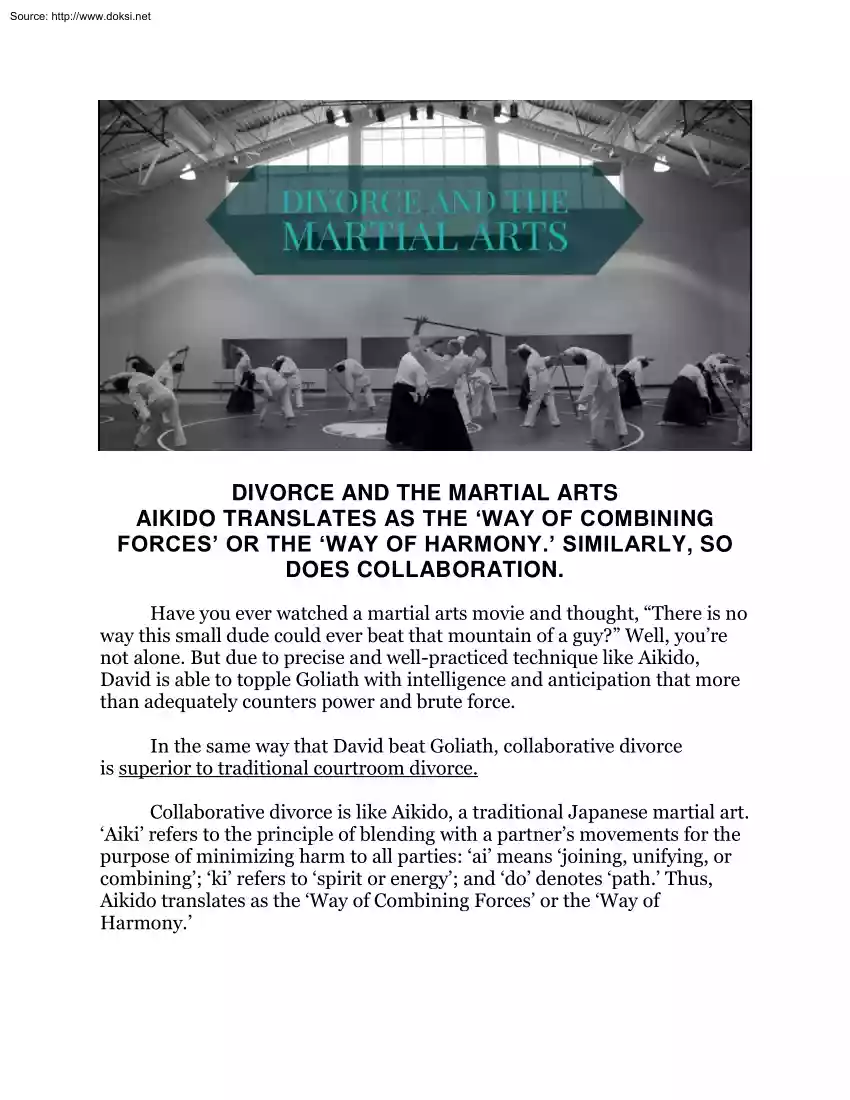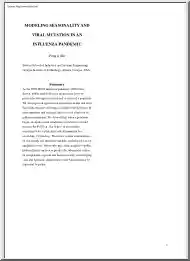A doksi online olvasásához kérlek jelentkezz be!

A doksi online olvasásához kérlek jelentkezz be!
Nincs még értékelés. Legyél Te az első!
Mit olvastak a többiek, ha ezzel végeztek?
Tartalmi kivonat
Source: http://www.doksinet DIVORCE AND THE MARTIAL ARTS AIKIDO TRANSLATES AS THE ‘WAY OF COMBINING FORCES’ OR THE ‘WAY OF HARMONY.’ SIMILARLY, SO DOES COLLABORATION. Have you ever watched a martial arts movie and thought, “There is no way this small dude could ever beat that mountain of a guy?” Well, you’re not alone. But due to precise and well-practiced technique like Aikido, David is able to topple Goliath with intelligence and anticipation that more than adequately counters power and brute force. In the same way that David beat Goliath, collaborative divorce is superior to traditional courtroom divorce. Collaborative divorce is like Aikido, a traditional Japanese martial art. ‘Aiki’ refers to the principle of blending with a partner’s movements for the purpose of minimizing harm to all parties: ‘ai’ means ‘joining, unifying, or combining’; ‘ki’ refers to ‘spirit or energy’; and ‘do’ denotes ‘path.’ Thus, Aikido translates as the ‘Way
of Combining Forces’ or the ‘Way of Harmony.’ Source: http://www.doksinet MORIHEI UESHIBA, THE FATHER OF AIKIDO. In Aikido, one applies aiki by, first, understanding the rhythm and intent of others to, second, find the optimal position and timing to connect and diffuse the conflict. This martial art was developed in the early 20th century by Morihei Uyeshiba, is based on harmony and love, and is rooted firmly in the eastern philosophical notions of dualism and polarity. I had a client for whom it was easy to explain his divorce choices because of how closely Aikido resembles the collaborative divorce process. I remember the sun pushing its fingers through my blinds, illuminating the brown leather couch in my office and casting a diagonal shadow on its cushions. It was a hot summer afternoon when my next consultation walked through the door, with a hint of anxiety playing in his eyes. “My name’s Joryn. It’s a pleasure to meet you” I greeted him, as I rose from my seat,
looked him in those eyes, and reached for his hand. “I’m pleased to make your acquaintance. My name’s Doshino” He inclined his torso slightly, over our clasped hands. I realized that he was bowing My assistant had already offered him something to drink, so I gestured invitingly towards the couch. “Please have a seat and tell me about your situation,” I said, while settling on the armchair facing him. “Yes,” He sat, with a quick, single nod. “My name’s Doshino,” he repeated “My wife and I have been married for nine years, but lately, it hasn’t been Source: http://www.doksinet working out. And now she’s announced that she wants a divorce” His English was heavily accented but very precise and correct. He continued, “I came from Japan at 15 with nothing but a suitcase, $96, a great deal of determination, and a black belt in Aikido.” I nodded my head approvingly and continued to listen. He went on, “When I was 35, I married an American woman who was
ten years younger than I am. We’ve never had children Now my wife tells me she wants a divorce. I own a house, my own business, and a car, and I have a mortgage payment and I really don’t know what to do,” he said in a subdued voice. He heaved a sigh, and then concluded by saying, “Also, I don’t understand divorce. Can you explain it to me? “Great!” I exclaimed, “My husband is a black belt in Aikido, as well, so here’s an analogy that may help explain,” I explained, with some excitement. “Collaborative Divorce is like Aikido where traditional courtroom divorce is like karate,” I continued passionately, “Aikido is more reciprocal, interest-based, if you will, unlike karate, which is more positional and adversarial.” A glimmer in his eyes indicated his appreciation of my simple attempt to clarify. I continued, “In keeping with the tenets of Aikido, Collaborative Divorce is a far more unifying form of peaceful negotiations, whereas courtroom divorce is a more
singular form of combat designed to thoroughly defeat one’s opponent and to ensure that he or she remains defeated forevermore.” After another hour of explaining the pros and cons of collaborative divorce, Doshino suddenly arose from the couch, leaving a deep imprint in the leather where he had been sitting. A shy smile perched on his lips as they pursed upwards. “Let’s not litigate; let’s collaborate!” he exclaimed. By using the collaborative method, Doshino and his wife, Kikyo, amicably split up their assets and worldly possessions using a financial neutral. In divorcing collaboratively, they avoided the emotional and financial battles that a traditional courtroom divorce fosters, along with the unfulfilled expectations that protracted litigation usually delivers
of Combining Forces’ or the ‘Way of Harmony.’ Source: http://www.doksinet MORIHEI UESHIBA, THE FATHER OF AIKIDO. In Aikido, one applies aiki by, first, understanding the rhythm and intent of others to, second, find the optimal position and timing to connect and diffuse the conflict. This martial art was developed in the early 20th century by Morihei Uyeshiba, is based on harmony and love, and is rooted firmly in the eastern philosophical notions of dualism and polarity. I had a client for whom it was easy to explain his divorce choices because of how closely Aikido resembles the collaborative divorce process. I remember the sun pushing its fingers through my blinds, illuminating the brown leather couch in my office and casting a diagonal shadow on its cushions. It was a hot summer afternoon when my next consultation walked through the door, with a hint of anxiety playing in his eyes. “My name’s Joryn. It’s a pleasure to meet you” I greeted him, as I rose from my seat,
looked him in those eyes, and reached for his hand. “I’m pleased to make your acquaintance. My name’s Doshino” He inclined his torso slightly, over our clasped hands. I realized that he was bowing My assistant had already offered him something to drink, so I gestured invitingly towards the couch. “Please have a seat and tell me about your situation,” I said, while settling on the armchair facing him. “Yes,” He sat, with a quick, single nod. “My name’s Doshino,” he repeated “My wife and I have been married for nine years, but lately, it hasn’t been Source: http://www.doksinet working out. And now she’s announced that she wants a divorce” His English was heavily accented but very precise and correct. He continued, “I came from Japan at 15 with nothing but a suitcase, $96, a great deal of determination, and a black belt in Aikido.” I nodded my head approvingly and continued to listen. He went on, “When I was 35, I married an American woman who was
ten years younger than I am. We’ve never had children Now my wife tells me she wants a divorce. I own a house, my own business, and a car, and I have a mortgage payment and I really don’t know what to do,” he said in a subdued voice. He heaved a sigh, and then concluded by saying, “Also, I don’t understand divorce. Can you explain it to me? “Great!” I exclaimed, “My husband is a black belt in Aikido, as well, so here’s an analogy that may help explain,” I explained, with some excitement. “Collaborative Divorce is like Aikido where traditional courtroom divorce is like karate,” I continued passionately, “Aikido is more reciprocal, interest-based, if you will, unlike karate, which is more positional and adversarial.” A glimmer in his eyes indicated his appreciation of my simple attempt to clarify. I continued, “In keeping with the tenets of Aikido, Collaborative Divorce is a far more unifying form of peaceful negotiations, whereas courtroom divorce is a more
singular form of combat designed to thoroughly defeat one’s opponent and to ensure that he or she remains defeated forevermore.” After another hour of explaining the pros and cons of collaborative divorce, Doshino suddenly arose from the couch, leaving a deep imprint in the leather where he had been sitting. A shy smile perched on his lips as they pursed upwards. “Let’s not litigate; let’s collaborate!” he exclaimed. By using the collaborative method, Doshino and his wife, Kikyo, amicably split up their assets and worldly possessions using a financial neutral. In divorcing collaboratively, they avoided the emotional and financial battles that a traditional courtroom divorce fosters, along with the unfulfilled expectations that protracted litigation usually delivers




